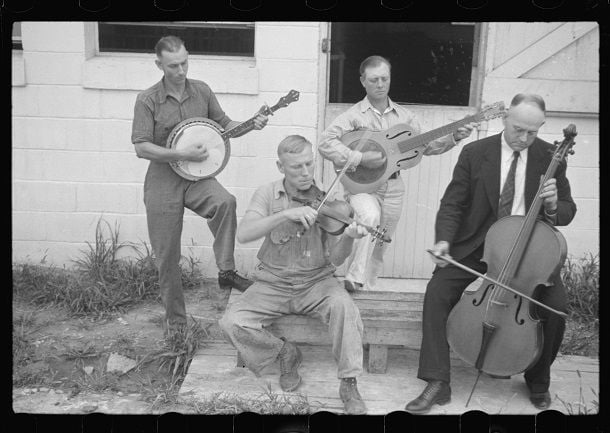Finger-pickin’ Good: American Banjo Classics
Co-producer and banjo extraordinaire Greg C. Adams talks about Classic Banjo, a collection of American tunes that show off modern banjo’s diverse roots
/https://tf-cmsv2-smithsonianmag-media.s3.amazonaws.com/filer/20130731010043Banjo-cover1.jpg)
The banjo conjures American musical icons: the overall-clad country band on an old porch, the bluegrass player in a sun-soaked field. Over the past century, famous players like Pete and Mike Seeger have established the instrument as an enduring piece of Americana.
Despite the banjo’s firm place in the American folk cannon, though, ethnomusicologist Greg C. Adams wants music fans to appreciate the eclectic, global contexts from which American banjo music grew. Since the instruments’ invention by enslaved Africans in the Caribbean nearly 400 years ago, the banjo has been picked up by a variety of cultures in and outside the Americas, each of which has contributed to the different ways America’s great banjoists have played.
For Classic Banjo, out this month on Smithsonian Folkways Recordings, Adams and archivist Jeff Place selected 30 of the past half-century’s best tracks by American banjo players that capture the diversity of American techniques and styles.
Adams, who has played the banjo for almost 20 years, recently talked to us about his love of the instrument, its history and what Classic Banjo means for a new generation of banjo enthusiasts.
Why make an album of American banjo classics?
Smithsonian Folkways is home to some of the most important recordings that reflect the ways the banjo is being used, especially in the 20th century. To have access to those materials, and to make those materials available, is vitally important to the ways in which we think about the broader history of the banjo. By the 1890s and moving forward, the banjo is increasingly used in the music industry. But how do we take what’s happened in the past century and compare it to how we understand the banjo’s broader history, which is a nearly 400-year history? How do we reflect upon the first 300 years of that history and embrace what we can learn from the 20th century forward? That’s why we put this album together.
What makes a good banjo track?
It’s a mix of the energy behind the performance, learning about the contexts of the performance and then learning who these people are and why they are significant. On the album, Tony Trischka and Bill Evans play the tune “Banjoland” with incredible precision. But you can also listen to “Golden Bell Polka,” by A.L. Camp, who at the time of this recording was a very old man. He’s playing this tune that would be associated with the late 19th and early 20th century, and so while you can tell he’s of an older generation by his performance, there’s still an integrity in his playing that says: ‘Yes, this man knew exactly what he was doing and in his day was an incredible player.’ It’s about appreciating not only the processes people go through as they learn to play the instrument, but how this process ties into the broader banjo tradition.
You had more than 300 albums to dig through in your search. How did you decide which tracks ultimately made the final cut?
We looked at several things. Who are some of the individuals that would need to be represented? What are some of the specific playing techniques that would need to be there? What kind of repertoire would help to reflect the vibrant nature of banjo music traditions? We have iconic people like Pete Seeger, Hobart Smith, or Mike Seeger, and we focus on playing techniques that are associated with, for example, bluegrass traditions, or with old time music—whether you’re talking about downstroke techniques such as clawhammer or frailing, as well as two- and three-finger picking styles. And then there are also people who are not picking the strings with their fingers, but using flat pics or plectrums.

How did these different techniques come about?
Different techniques materialize in different ways. In the 19th century, downstroke techniques were associated with the banjo’s commercialization through black-face minstrelsy and instruction books that taught African American techniques. This way of playing the banjo shares the same fundamentals with what we see in old time music circles, so if you see somebody playing clawhammer banjo—they would also call it frailing the banjo or thumping the banjo—you have a fundamental technique that unfolds in different ways, within different geographic locations, within different communities. Nobody’s going to play the banjo in the exact same way.
Banjo is increasingly prevalent in popular radio music, like songs by the band Mumford and Sons. What do you hope a young generation of banjo enthusiasts take away from this record?
What listeners are hearing people do today ties back to traditions that are hundreds of years old. It’s part of a much larger continuum. What they’re hearing in popular music, and perhaps what they’ll hear on a recording such as Classic Banjo, will inspire them to look deeper beyond just the sound of the instrument to the multicultural contexts in which the banjo exists. My hope is that we can reach as wide a public as possible.
What’s the benefit of the banjo’s growing popularity?
I feel like with the latest wave of popular awareness, we have a unique opportunity to really deconstruct the banjo’s use over time, coming out of slavery, its popular use though black-face minstrelsy, the way that it’s being gradually commercialized and what brings us to associate it more recently with old time and blue grass traditions. There’s a chance to have more of a conversation about the deeper aspects of this history. The banjo is not just a stereotype anymore. It is a gateway to understanding the American experience.
/https://tf-cmsv2-smithsonianmag-media.s3.amazonaws.com/accounts/headshot/paul-bisceglio-240.jpg)
/https://tf-cmsv2-smithsonianmag-media.s3.amazonaws.com/accounts/headshot/paul-bisceglio-240.jpg)